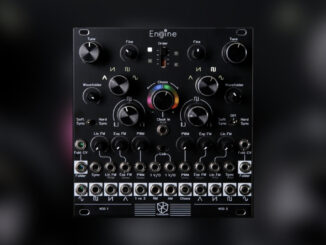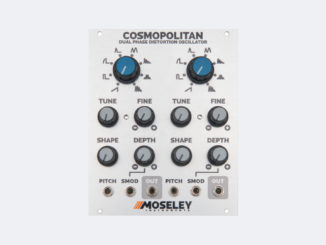Hieroglyphic Plume is a new digital stereo oscillator that brings fully tweakable pulsar synthesis from Curtis Roads to Eurorack.
There are a huge number of oscillators on the market, from classic analog designs to super modern concepts. However, it can be seen that concepts are often repeated, and completely new ideas are rather rare, especially on the synthesis side.
Before the Superbooth, a new manufacturer called Herioglyphic introduced a new fascinating digital oscillator based on a special synthesis type.
Hieroglyphic Plume
Launching a module right before the Superbooth and not being there is not ideal, as there are a huge number of modules released there that are in the focus of media. So, I’m only now getting to the new Hieroglyphic Plume module because the storm of new releases has now passed.
Plume is a new digital oscillator that is based on pulsar synthesis that belongs to the granular synthesis category. It’s “based directly on the Curtis Roads article “Sound Composition with Pulsars,” where he describes a technique that uses an impulse generator to trigger arbitrary wave shapes.”
The developers add that it takes an approach to sound and rhythm that is somewhere between an oscillator, granulator, and a clock generator.
Two soft synths are available that apply Pulsar synthesis: NUKLEAR from Hamburg-Audio, released in 2011, and RayBlaster from Tone2, which uses a further development of the technique called Impulse Modeling Synthesis (IMS).
Module Details
Back to the module. Plume is a stereo oscillator that operates at 96kHz/24-bit. It has a silver front panel with sliders and knobs that resemble the design of Mutable Instruments a bit. The oscillator engine can work as a pulsar synthesis oscillator, LFO, or both simultaneously.
YouTuber DivKid asked the developer about the concept and the operation. Hieroglyphic said:
The impulse generator controls Plume’s fundamental frequency, while the wave shape frequency called formant – modifies the timbres. Crossfading, wave folding and amplitude modulation can then be applied to each wave shape.
Lastly, the masking stage allows for advanced stereo location and imulse train modification.
The module has various controls, allowing you to shape the impulse generator: formant, cluster, wave shaping, West Coast style wave folder, pitch, and fine-tune. There is also an option to hard-sync the oscillator.
Then, the masking section of Hieroglyphic Plume introduces interruptions in the pulse train by masking individual pulses, using the burst probability and reset pan sliders. You can use the masking function to create advanced specialization. The window section on its side, controls the overall volume curve of the pulse.
Nice is that all parameters are CV controllable, giving you many options to bring movement into the oscillator.
First Impression
Yes, what this Eurorack oscillator does sounds like hieroglyphics to many at first. It is also difficult to describe in words to sound it more easy. The first videos, however, help a lot to get an idea of what the Plume oscillator can do and of its sonic capabilities.
I really like the results from the first demos. From what I’ve heard, the modulated/shaped results here sound very exciting and very organic. They are different from what you usually here from traditional oscillators. I’m looking forward to more demos.
Hieroglyphic Plume is available now for $349,99/330€+ VAT.
More information here: Hieroglyphic
Available at my partner






How would the hieroglyphic plume work with a
moog mavis?
as Plume is an oscillator and not an shaper or effects processor, you can mix into the signal and play it with the same 1v/oct signal.